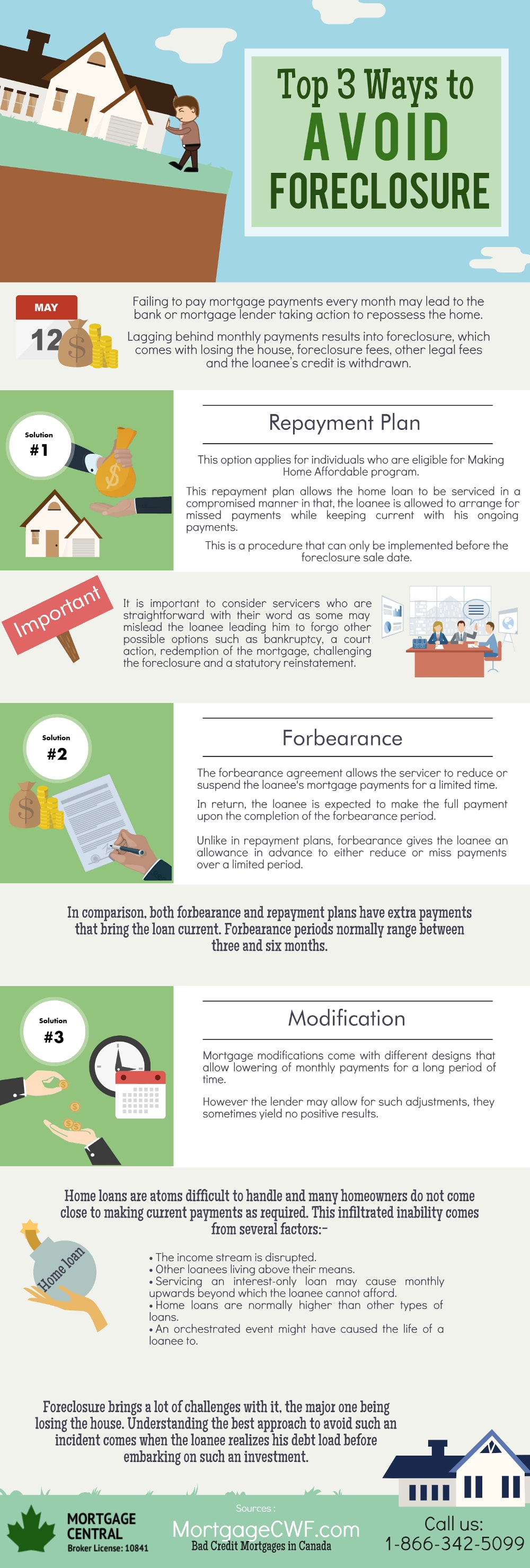Get Pre-Approved Now
Top 3 Ways to Avoid Foreclosure
Use the Code Below to Embed this Infographic into Your Website!
Top 3 Ways to Avoid Foreclosure
Failing to pay mortgage payments every month may lead to the bank or mortgage lender taking action to repossess the home. At least, according to the lender, the house does not belong to the loanee until the mortgage is successfully completed. It is considered both the loanee and loaner own the house until the mortgage is cleared. Lagging behind monthly payments results into foreclosure, which comes with losing the house, foreclosure fees, other legal fees and the loanee’s credit is withdrawn.
Repayment Plan
This option applies for individuals who are eligible for Making Home Affordable program. This repayment plan allows the home loan to be serviced in a compromised manner in that, the loanee is allowed to arrange for missed payments while keeping current with his ongoing payments. This can only work if the loanee’s income is good enough to cover both current and makeup monthly payments. If it takes longer than the loanee’s plan, it is advisable for the services to request permission from the lender on grounds of postponing the foreclosure sale date if at all the servicer will sign off the loanee’s proposed plan. This extension serves to provide sufficient time to work out on how to finish up the mortgage or at least develop a fighting chance before closure. It is important to consider servicers who are straightforward with their word as some may mislead the loanee leading him to forgo other possible options such as bankruptcy, a court action, redemption of the mortgage, challenging the foreclosure and a statutory reinstatement.
Several states give the loanee the change to reinstate his mortgage within a limited time. This is a procedure that can only be implemented before the foreclosure sale date. Other states have the option of redeeming the house by paying the mortgage in full including the relevant interest and costs. If the loanee has the financial capability to reinstate the mortgage, he should consider a repayment program as the first option to reinstating or redeeming the house. However, the loanee should not expect reduction of his monthly payments as a way of reinstating the missed payments. Instead, consider redeeming the mortgage by refinancing the same at a much lower interest rate.
Forbearance
The forbearance agreement allows the servicer to reduce or suspend the loanees mortgage payments for a limited time. In return, the loanee is expected to make the full payment upon the completion of the forbearance period. This also comes with the extra amount that caters for missed payments. This kind of agreement is common with individuals who have lost their jobs or called for military duties for a relatively short time. Such individuals may not be able to make any payments in the present but will probably catch up soon. Unlike in repayment plans, forbearance gives the loanee an allowance n advance to either reduce or miss payments over a limited period. In comparison, both forbearance and repayment plans have extra payments that bring the loan current. Forbearance periods normally range between three and six months.
Modification
Mortgage modifications come with different designs that allow lowering of monthly payments for a long period of time. However the lender may allow for such adjustments, they sometimes yield no positive results. Home loans are atoms difficult to handle and many homeowners do not come close to making current payments as required. This infiltrated inability comes from several factors:
- The income stream is disrupted in cases where the loanee lost his job, is injured or finds a new job but with a much lesser pay.
- Other loanees may be living above their means which dictates predatory loan practices or personal misstatements on their income and debt load.
- Servicing an interest-only loan may cause the principal to hit its preset cap hence dictating the monthly upwards beyond which the loanee cannot afford.
- Home loans are normally higher than other types of loans. The unresolved issue is the short-term interest rates that are implemented by the Federal Reserve.
- An orchestrated event might have caused the life of a loanee to change thereby changing their priority in their budget.
Its important to understand that once a mortgage loanee realizes he cannot afford his mortgage payment at the moment, it should dictate that he will not be able to finance the same in the near future. Here thereto, the best approach for such an individual would be mortgage modification.
Foreclosure brings a lot of challenges with it, the major one being losing the house. Understanding the best approach to avoid such an incident comes when the loanee realizes his debt load before embarking on such an investment. Its imperative for individuals to consider a well-balanced approach when facing foreclosure. The loanee should be able to consider repayment plans, forbearance plans and modification of mortgages as part of his recovery campaign.




